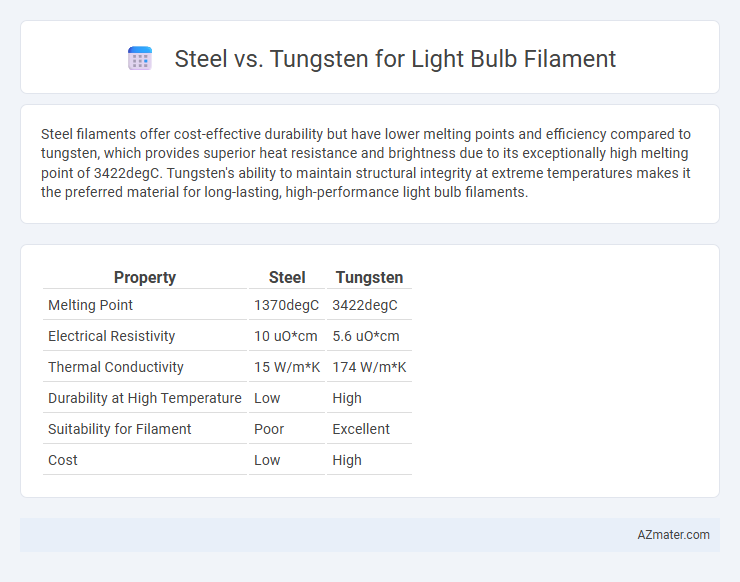Steel filaments offer cost-effective durability but have lower melting points and efficiency compared to tungsten, which provides superior heat resistance and brightness due to its exceptionally high melting point of 3422degC. Tungsten's ability to maintain structural integrity at extreme temperatures makes it the preferred material for long-lasting, high-performance light bulb filaments.
Table of Comparison
| Property | Steel | Tungsten |
|---|---|---|
| Melting Point | 1370degC | 3422degC |
| Electrical Resistivity | 10 uO*cm | 5.6 uO*cm |
| Thermal Conductivity | 15 W/m*K | 174 W/m*K |
| Durability at High Temperature | Low | High |
| Suitability for Filament | Poor | Excellent |
| Cost | Low | High |
Introduction to Light Bulb Filament Materials
Light bulb filaments require materials with high melting points and excellent electrical conductivity to withstand intense heat and maintain durability. Tungsten is the most commonly used filament material due to its melting point of 3422degC and high tensile strength, allowing it to operate efficiently at high temperatures. Steel filaments, although having lower cost and reasonable strength, have significantly lower melting points around 1370degC, making them less suitable for long-lasting, high-performance light bulbs.
Historical Evolution of Filament Materials
Early light bulb filaments primarily used carbonized bamboo before transitioning to tungsten due to its superior melting point of 3422degC and excellent durability. Steel filaments were briefly experimented with but proved less efficient because of their lower melting point and tendency to oxidize, limiting their lifespan and brightness. Tungsten quickly became the standard filament material by the early 20th century, revolutionizing incandescent bulbs with higher efficiency and longer operational life.
Chemical Properties: Steel vs Tungsten
Tungsten exhibits superior chemical stability and a much higher melting point (3422degC) compared to steel, making it ideal for light bulb filaments that endure extreme heat without oxidizing rapidly. Steel, primarily composed of iron and carbon, oxidizes and degrades at lower temperatures due to iron's reactivity with oxygen, limiting its filament lifespan. The inertness and high melting point of tungsten contribute to its durability and consistent light emission in incandescent bulbs.
Electrical Conductivity Comparison
Tungsten has significantly higher electrical conductivity than steel, making it the preferred material for light bulb filaments due to its efficient current flow and reduced energy loss. Its superior conductivity combined with a high melting point allows tungsten filaments to operate at temperatures around 2500degC, producing bright light without melting. Steel's lower electrical conductivity and melting point limit its effectiveness and durability in filament applications, causing it to be less suitable for high-performance incandescent bulbs.
Melting Point and Thermal Stability
Tungsten boasts a melting point of approximately 3422degC, significantly higher than steel's melting range of 1370-1510degC, making it ideal for light bulb filaments exposed to intense heat. Its superior thermal stability allows tungsten filaments to operate at higher temperatures without melting, resulting in brighter and more efficient light output. Steel filaments, with lower thermal stability, cannot sustain such high temperatures, leading to reduced lifespan and inferior performance in incandescent bulbs.
Filament Lifespan and Durability
Tungsten filaments in light bulbs offer superior lifespan and durability compared to steel due to tungsten's higher melting point of 3422degC and excellent thermal stability. Steel filaments, with a melting point around 1370degC, degrade faster under high temperatures, resulting in shorter operational life and susceptibility to oxidation. Tungsten's robustness enables it to withstand prolonged electrical currents and intense heat, making it the preferred material for long-lasting light bulb filaments.
Efficiency and Energy Consumption
Tungsten filaments exhibit superior efficiency and lower energy consumption compared to steel due to tungsten's higher melting point and better electrical conductivity, allowing bulbs to operate at higher temperatures with greater luminous efficacy. Steel filaments, while cheaper, incur greater energy loss as heat and exhibit shorter lifespans under high operating temperatures, reducing overall efficiency. The choice of tungsten significantly enhances energy savings and bulb longevity, making it the preferred material in modern incandescent light bulbs.
Cost and Economic Factors
Steel filaments offer a significantly lower production cost compared to tungsten due to the abundance and reduced extraction expenses of steel. Tungsten's high melting point and superior durability increase initial manufacturing costs but provide longer lifespan and greater energy efficiency, potentially lowering overall replacement frequency and operational expenses. Economic viability depends on balancing upfront expenditure with maintenance savings, making steel suitable for budget-conscious applications and tungsten preferred for long-term performance investments.
Environmental Impact and Sustainability
Steel filaments in light bulbs exhibit higher recyclability and lower environmental toxicity compared to tungsten, which involves extensive mining with significant ecological disruption. Tungsten production demands energy-intensive extraction and processing, contributing to greater carbon emissions and resource depletion. Choosing steel filaments supports sustainable manufacturing practices due to its abundance and reduced environmental footprint throughout the product lifecycle.
Conclusion: Optimal Choice for Light Bulb Filaments
Tungsten remains the optimal choice for light bulb filaments due to its exceptionally high melting point of 3422degC and superior tensile strength, which allow it to withstand extreme temperatures without melting or deforming. Steel, although strong and more readily available, has a significantly lower melting point around 1370degC, making it less suitable for the high-heat environment inside a light bulb. The durability and efficiency of tungsten filaments ensure longer lifespan and consistent light output, solidifying its dominance in lighting technology.

Infographic: Steel vs Tungsten for Light Bulb Filament
 azmater.com
azmater.com